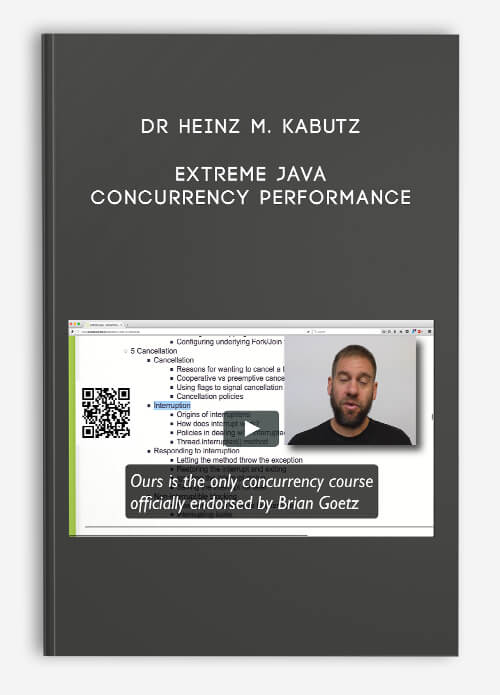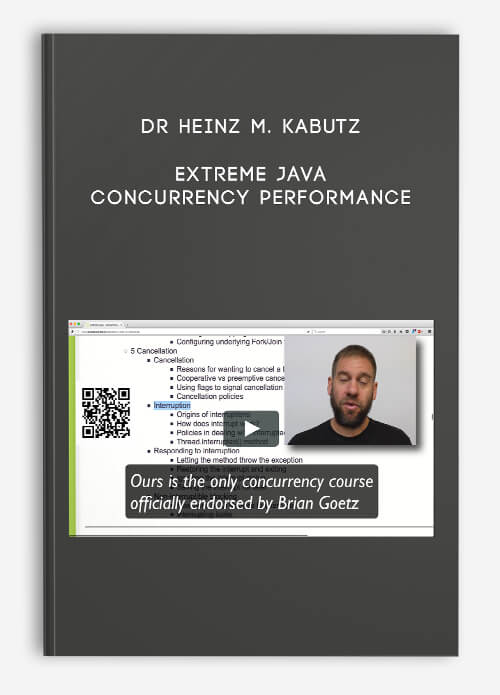Dr Heinz M. Kabutz – Extreme Java – Concurrency Performance
$797.00 $142.00
Product Include:
File size:
Dr Heinz M. Kabutz – Extreme Java – Concurrency Performance
**More information:
Get Dr Heinz M. Kabutz – Extreme Java – Concurrency Performance at Salaedu.com
Description
This course could be your most productive learning experience ever! It is aimed at the busy Java professional who wants to quickly learn and apply new essentials on core Java topics. All topics have been thoroughly researched by Dr Heinz Kabutz, famous in over 145 countries for his Java Specialists’ Newsletter .
Extreme Java – Concurrency Performance is only concurrency course endorsed by Brian Goetz, author of the best-seller Java Concurrency in Practice. Our course is loosely based on Goetz’ excellent book, but adapted for modern Java.
During the course we use the new Java 8 syntax for lambdas and streams, making the code more readable. You will learn about threading, performance, compare-and-swap non-blocking constructs, garbage collectors and many other topics that you will be able to quickly apply in your own work. We will also cover all relevant constructs found in Java 8, such as StampedLock, LongAdder, parallel streams and many more. As a side effect, you will get familiar with Java 8 lambdas and streams.
Please look at the outline to see all the topics covered. During the training, you will always get a chance to try out what you have learned in carefully thought out exercises. This will help you understand and quickly internalize what you have just learned.
Is this course for you?
Students who have successfully completed this course, can expect the following outcomes:
- Throughout the course, we use the new Java 8 syntax. The first outcome would thus be an understanding of how lambdas and streams work in Java 8.
- Students gain a good understanding of why threads are important and what the risks are. They learn how to share objects safely, including visibility concerns. They also master safety techniques of thread confinement, stack confinement and object confinement. Through this, they learn how to design a thread-safe class.
- They will know the difference between a synchronized and a concurrent collection and when to use which one. This is particularly important to be able to write high-performance code that scales well.
- They would understand how a blocking queue can be used to build producer consumer systems and what the various blocking queues are in Java.
- They would know how Semaphore, CountDownLatch and Phaser works.
- Students would learn how to use the thread pool executors to run tasks asynchronously. They would also learn how to configure these, including how to cope with an unexpected number of tasks and how the various settings interact.
- They will learn how to break up a large tasks into smaller tasks by choosing good task boundaries, resulting in tasks that are homogeneous and independent.
- They would learn how to cleanly cancel tasks that have been started by using interruptions and volatile boolean fields.
- Students would learn how the Fork/Join Pool works by comparing it to a normal single-threaded recursive algorithm. They will also get an opportunity to refactor a piece of Fork/Join Code to use parallel streams instead, in order to see how Java 8 can make coding a bit easier.
- Students would know how to detect and solve liveness issues, such as deadlock, livelock and contention.
- They would also know how to find and solve performance bottlenecks, especially in threaded code.
- They would know how ReentrantLock, ReentrantReadWriteLock and the new Java 8 StampedLock work and how we can use that to write efficient code using optimistic techniques.
- They would know how to write their own synchronizers when needed, by creating state-dependent classes.
- Students would understand what atomic classes are and know techniques to use them to build efficient non-blocking classes that offer better performance under contention.
- They would understand the most common garbage collection algorithms: throughput, concurrent and G1 and also how to tune each one to give best performance.
- They would know how to discover performance bottlenecks in an application and also how to solve these. They would also learn how profilers can be used to find bottlenecks and the role of microbenchmarks in confirming these.
- Throughout the course, a strong emphasis is placed on the practical application of learning. Each student needs to complete a set of exercises to demonstrate that they have understood the material.
After successful completion of the course and all the exercises, students qualify for a “course completion certificate” similar to the following:
Your Instructor
Heinz Kabutz is the author of The Java Specialists’ Newsletter, a publication enjoyed by tens of thousands of Java experts in over 145 countries. His book “Dynamic Proxies (in German)” was #1 Bestseller on Amazon.de in Fachbücher für Informatik for about five minutes until Amazon fixed their algorithm. Thanks to a supportive mother, he has now sold 5 copies.
Heinz’s Java Specialists’ newsletter is filled with amusing anecdotes of life on the Island of Crete. He is a popular speaker at all the best Java conferences around the world, and also at some of the worst. He teaches Java courses in classrooms around the world, where his prime objective is to make absolutely sure that none of his students fall asleep. He is not always successful.
Course Curriculum
-
Start
ExtremeJavaConcurrency-2.1 Slides
-
Start
Exercise Files
-
Preview
How the course came about (5:06)
-
Preview
Questions and exercises (11:17)
-
Start
History of concurrency (4:08)
-
Start
Benefits of threads (9:46)
-
Start
Risks of threads (8:19)
-
Start
Threads are everywhere (3:58)
-
Start
Short Java 7 & 8 primer (23:15)
-
Start
Exercises (4:54)
-
Preview
Exercise Walkthrough: Setting up your IDE (5:27)
-
Preview
Exercise Walkthrough: Annotating Persons (4:11)
-
Start
Stack vs heap memory (9:58)
-
Start
Synchronization, Latent defects (5:25)
-
Start
Atomicity (9:05)
-
Preview
Visibility (8:37)
-
Start
Confinement (7:37)
-
Preview
Immutability (15:54)
-
Start
Designing a thread-safe class (8:48)
-
Start
Exercises (4:19)
-
Start
Exercise Walkthrough: Thread confined DateFormat (4:10)
-
Start
Exercise Walkthrough: Stack confined DateFormat (2:10)
-
Start
Exercise Walkthrough: Object confined DateFormat (1:31)
-
Start
Exercise Walkthrough: New DateTimeFormatter (2:46)
-
Start
Exercise Walkthrough: ByteGenerator (5:32)
-
Start
Synchronized collections (13:07)
-
Start
Concurrent collections (8:38)
-
Preview
Livelock with ConcurrentHashMap.computeIfAbsent() (10:06)
-
Start
CopyOnWrite collections (10:45)
-
Start
BlockingQueue & producer-consumer (15:57)
-
Start
Semaphore (5:23)
-
Start
CountDownLatch (4:42)
-
Start
Phaser (7:45)
-
Start
Exercises (2:26)
-
Start
Exercise Walkthrough: ConcurrentModificationException (19:57)
-
Start
Exercise Walkthrough: PriorityBlockingQueue (12:36)
-
Start
Introduction (4:36)
-
Start
The executor framework (8:44)
-
Start
ScheduledExecutorService (7:22)
-
Start
Executor lifecycle (6:32)
-
Start
Finding exploitable parallelism (7:20)
-
Start
Callable and Future (6:02)
-
Start
CompletionService (6:50)
-
Start
CompletableFuture (15:53)
-
Start
Using parallel streams (6:34)
-
Start
Exercises (1:44)
-
Start
Exercise Walkthrough: Parallel factorizer (9:41)
-
Start
Exercise Walkthrough: Parallel stream factorizer (4:27)
-
Preview
Introduction & Motivation (11:25)
-
Start
Cooperative vs preemptive (5:05)
-
Start
Policies in dealing with InterruptedException (13:55)
-
Start
Code sample with Future.cancel(true) (11:55)
-
Start
FutureTask life cycle & Java 8 streams (7:09)
-
Start
Timed tasks & non-interruptible tasks (7:17)
-
Start
Exercises (0:57)
-
Start
Exercise Walkthrough: Make the factorizer cancelable (7:35)
-
Start
Sizing thread pools, compute vs IO tasks (12:39)
-
Start
Mixing CPU and IO intensive tasks (3:35)
-
Start
Thread creation cost amortization (23:59)
-
Start
Fixed vs cached thread pool configurations (6:47)
-
Start
Saturation policies & thread factories (6:47)
-
Start
Exercises (3:03)
-
Start
Exercise Walkthrough: ThreadPoolSupplier (5:50)
-
Start
Exercise Walkthrough: Thread Pool MBean (6:16)
-
Start
Exercise Walkthrough: Sizing ThreadPoolExecutor (4:07)
-
Preview
Introduction (3:55)
-
Start
ForkJoinPool and ForkJoinTask (6:16)
-
Start
Parallelizing Fibonacci with Fork:Join (13:15)
-
Start
ManagedBlocker (17:04)
-
Start
Canceling a task and summary (4:26)
-
Start
Exercises (7:26)
-
Preview
Exercise Walkthrough: Puzzle solver with ForkJoin (14:53)
-
Start
Exercise Walkthrough: Streams instead of ForkJoin (13:11)
-
Start
Introduction (2:32)
-
Start
Deadlocks (10:15)
-
Preview
Lock ordering with System.identityHashCode() (9:51)
-
Start
Benefits of open calls (7:01)
-
Start
Deadlock in java.util.Vector (8:11)
-
Start
Avoiding and diagnosing deadlocks (18:21)
-
Start
Livelocks (7:36)
-
Start
Exercises (4:15)
-
Start
Exercise Walkthrough: Solve deadlocks via lock ordering (3:47)
-
Start
Exercise Walkthrough: Find and eliminate deadlock (11:16)
-
Start
Exercise Walkthrough: Bonus deadlock puzzle (3:21)
-
Start
Introduction (6:55)
-
Start
Automatic tooling (7:22)
-
Start
Bulk updates (13:14)
-
Start
Repairing the race condition (4:01)
-
Start
Testing for performance (5:43)
-
Start
Exercises (3:53)
-
Start
Exercise Walkthrough: HandoverQueue test (15:43)
-
Start
Exercise Walkthrough: LinkedTransferQueue test (7:18)
-
Start
Introduction (7:12)
-
Start
Amdahl’s & Little’s laws (9:13)
-
Start
Costs introduced by context switching (12:46)
-
Start
Reducing lock contention (6:21)
-
Start
Lock splitting & lock striping (6:32)
-
Start
Monitoring CPU utilization to spot contention (7:23)
-
Start
Introduction (0:56)
-
Preview
AutoCloseable locks (8:05)
-
Start
Avoiding deadlocks using tryLock() (3:14)
-
Start
Performance synchronized vs ReentrantLock (3:33)
-
Start
When to use ReentrantLock (5:22)
-
Start
ReentrantReadWriteLock (6:06)
-
Start
StampedLock from Java 8 (13:57)
-
Start
Exercises (2:33)
-
Start
Exercise Walkthrough: Better WalkingCollection (7:58)
-
Start
Exercise Walkthrough: tryLock() for solving deadlocks (5:57)
-
Start
Exercise Walkthrough: StampedLock with IntList (22:24)
-
Start
Introduction (3:15)
-
Start
Managing state dependence (10:37)
-
Start
Using condition queues (12:20)
-
Start
Explicit condition objects (8:55)
-
Start
Exercises (1:30)
-
Start
Exercise Walkthrough: FutureResultIterable (17:31)
-
Start
Introduction (9:27)
-
Start
CompareAndSwap & VarHandles (23:45)
-
Start
Shared cache lines & sun.misc.Contended (20:00)
-
Start
Atomic variable classes (6:41)
-
Start
Nonblocking algorithms (6:04)
-
Start
Exercises (4:15)
-
Start
Exercise Walkthrough: Make an atomic BankAccount (8:35)
1 review for Dr Heinz M. Kabutz – Extreme Java – Concurrency Performance
Add a review Cancel reply
Related products
Business & Marketing
Business & Marketing
Business & Marketing
Business & Marketing
Jerry Banfield with EDUfyre – Master Entrepreneurship Online











king –
We encourage you to check Content Proof carefully before paying.“Excepted” these contents: “Online coaching, Software, Facebook group, Skype and Email support from Author.”If you have enough money and feel good. We encourage you to buy this product from the original Author to get full other “Excepted” contents from them.Thank you!